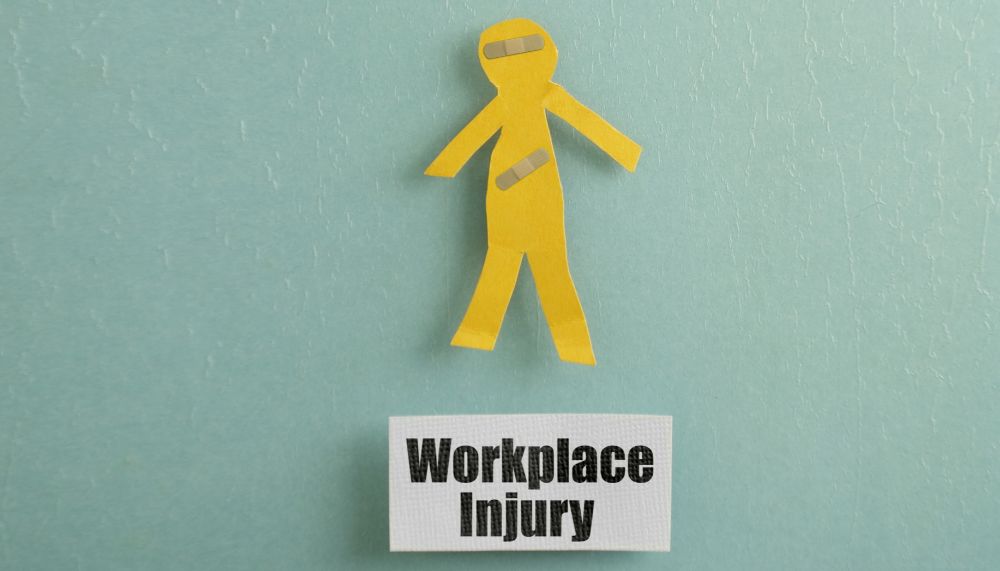Call For A Free Consultation
415-897-4801
Novato Corporate Office (Mailing Address):
10 Commercial Blvd #206 Novato, CA 94949
Offices Located In San Francisco, Oakland, San Jose, Walnut Creek, Pleasanton, Santa Rosa, Napa, Redwood City, Sacramento and Newark
What Are the Top 5 Workplace Injuries?
Workplace accidents can occur in a variety of workplace settings. Employers in California have a legal obligation to provide a safe and healthy work environment for their employees. The California Division of Occupational Safety and Health (Cal/OSHA) is responsible for enforcing state occupational safety and health regulations to prevent workplace injuries and illnesses. It is useful to know about the most common workplace injuries. This allows you to avoid them and learn what to do in the case that they should happen to you.

According to data from Cal/OSHA, the top 5 most frequently reported workplace injuries in California are:
- Sprains, Strains, and Tears
Sprains are often the result of a sudden twist or fall that puts excessive stress on the ligament. Strains are often the result of repetitive motions, such as lifting heavy objects or working at a computer for extended periods. It can also occur due to sudden movements like slipping and falling. Lastly, tears can be the result of a sudden, forceful movement or a gradual accumulation of stress.In the workplace, these types of injuries can be prevented through a combination of proper training, ergonomic design, and the use of personal protective equipment. - Cuts and Lacerations
Some of the most common causes of cuts and lacerations in the workplace include:- Sharp Objects: Employees who work with sharp tools, machinery, or equipment are at risk of cuts and lacerations.
- Slips, Trips, and Falls: Falls can cause cuts and lacerations if the employee lands on a sharp or jagged object.
- Fragile Objects: Workers who handle glass or other fragile objects are at risk of cuts and lacerations if the objects break or shatter.
- Moving Machinery: Workers who operate or work near moving machinery, such as conveyor belts or assembly lines, are at risk of cuts and lacerations from the machinery or its components.
- Poorly Maintained Equipment: Equipment that is not properly maintained, such as dull blades or broken glass, can cause cuts and lacerations.
To prevent cuts and lacerations in the workplace, employers should provide adequate training and personal protective equipment. They should also maintain equipment and machinery in good working condition.
- Bruises and Contusions
Bruises and contusions occur when an area of the body is struck by a hard object, such as a tool, machinery, or equipment. They can also happen when a person falls or collides with a hard surface.To prevent these types of injuries, employers should take steps to address workplace hazards, such as cluttered walkways or poorly maintained equipment. Additionally, employees should take steps to protect themselves. This includes wearing protective clothing, using equipment properly, and reporting any hazards or incidents. - Fractures
A fracture is a break in a bone. This can occur in the workplace due to a variety of factors, including:- Falls: Falls from heights, such as from ladders or scaffolding, or falls onto hard surfaces, can cause fractures.
- Repetitive Motions: Repetitive motions, such as repetitive lifting, can put stress on bones and lead to fractures over time.
- Trauma: Sudden trauma, such as being hit by a heavy object or colliding with a hard surface, can cause fractures.
- Osteoporosis: Workers with osteoporosis, a condition that weakens bones and makes them more prone to breaking, are at increased risk of fractures in the workplace.
To prevent fractures, employers should provide accommodations for workers with osteoporosis or similar conditions.
- Back Injuries
Back injuries are a common type of workplace injury that can happen due to:- Lifting Heavy Objects: Lifting heavy objects without proper training, technique, or equipment can put excessive stress on the back and lead to injuries.
- Poor Posture: Sitting or standing for long periods in an awkward position can put stress on the back and lead to injuries.
- Trauma: Sudden trauma, such as a fall or collision, can cause back injuries.
- Stress: Stress and tension, especially when combined with physical demands, can put additional strain on the back, leading to injuries.
Employees can minimize the risk of back injury by lifting heavy objects properly, maintaining good posture, and reporting any hazards or incidents.
FAQs
Q: Which workers are at the highest risk for injury?
A: In general, workers in physically demanding and hazardous industries, as well as those who work with heavy machinery or hazardous materials, are at increased risk for injury. Some of the workers who are at the highest risk for injury include those who work in:
- Construction
- Manufacturing
- Healthcare
- Agriculture
- Transportation
- Sanitation
Q: Can I sue if I get injured at work?
A: In some cases, you may be able to file a claim against your employer if you were injured on the job due to the employer’s negligence. For example, you may be able to claim for damages if your employer failed to:
- Provide a safe working environment.
- Provide proper training.
- Correct a known hazard.
However, in most cases, the workers’ compensation system is the exclusive remedy for workplace injuries. You cannot file a claim against your employer for damages.
Q: How can I avoid injury as a healthcare worker?
A: As a healthcare worker, it is important to take steps to reduce your risk of injury and maintain a safe work environment. Some tips to help you avoid injury include:
- Using proper lifting techniques for patients or heavy objects
- Using assistive devices, such as wheelchairs or transfer boards
- Maintaining good posture
- Taking frequent breaks to stretch and move around
Q: Which age group is injured at work most often?
A: Young workers, especially those in their first job, are at higher risk for injury due to their lack of experience and the potential for hazardous working conditions. However, middle-aged workers are also at a higher risk for injury. This is due to factors such as the physical demands of their work and the onset of age-related conditions such as arthritis.
Connect With an Injury Lawyer Who Can Help You Get Compensation
If you have been injured in the workplace, our team at Rush Injury Law knows how challenging this can be. On top of emotional or physical pain, the process for getting workplace compensation or taking your employer to court can be overwhelming and complicated. Contact our injury lawyer today for a consultation to learn how you can get justice for your workplace-related injury.
Want A Free Consultation?
© 2025 Rush Injury Law. All Rights Reserved.














